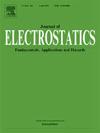Electric charge neutralization of granular materials using an air-assisted ionizer under different operational conditions
IF 2.1
4区 工程技术
Q3 ENGINEERING, ELECTRICAL & ELECTRONIC
引用次数: 0
Abstract
An operation of electric charge neutralization is often integrated in complex electrostatic separation processes targeted at the selective sorting of the constituents of granular mixtures in a wide range of industrial applications. The aim of the present work is to prove the possibility of increasing the charge elimination efficiency of a commercial air-assisted neutralizer, under various dynamic conditions simulating realistic industrial scenarios. Three experimental setups were tested. In the first one, particles were charged by triboelectric effect and then transported by a grounded metallic conveyor belt before being subjected to ionic bombardment from the commercial neutralizer. The second configuration employed a custom-designed rotating-roll corona-electrostatic separator. Particles were charged by corona discharge and then transported on the rotating roll electrode before being neutralized by an air-assisted ionizer installed opposite the roll electrode. In the third experimental configuration, the neutralization system was installed downstream from the particle detachment step of the second configuration. After being dislodged from the grounded rotating drum by a mechanical brush, the charged insulating particles fell freely under gravity through the ionization zone. This zone comprised the commercial ionizing neutralizer positioned opposite a grounded rectangular metal plate. The factors investigated were the applied voltage (Un) and the distance (dn) between the neutralizing electrode and the grounded (belt, roll, the plate) electrode, as well as the air velocity (v). The findings highlight the substantial role of airflow in enhancing ion dispersion and promoting charge neutralization, particularly through its interaction with the electric field geometry and particle dynamics. For instance, residual charge-to-mass ratio dropped to as low as 1–2 nC/g in the first configuration at air velocity of 2 m/s. This study clearly demonstrates the critical importance of finely tuning geometry, electrical field strength, and air dynamics to optimize electrostatic neutralization. These findings provide valuable guidelines for designing more efficient electrostatic separation systems, particularly for industrial recycling processes involving insulating materials.
用空气辅助电离器在不同操作条件下对颗粒状材料的电荷中和作用
在广泛的工业应用中,电荷中和的操作通常集成在针对颗粒混合物成分选择性分选的复杂静电分离过程中。本工作的目的是证明在模拟现实工业场景的各种动态条件下,提高商用空气辅助中和剂的电荷消除效率的可能性。测试了三种实验装置。在第一种方法中,粒子通过摩擦电效应带电,然后由接地的金属传送带输送,然后受到商业中和剂的离子轰击。第二种配置采用定制的转辊电晕静电分离器。粒子通过电晕放电充电,然后在旋转的辊电极上传输,然后被安装在辊电极对面的空气辅助电离器中和。在第三种实验配置中,中和系统安装在第二种配置的粒子分离步骤的下游。带电的绝缘粒子被机械电刷从接地的旋转滚筒中移出后,在重力作用下自由下落,通过电离区。该区域包括商用电离中和器,位于接地的矩形金属板对面。研究的因素是施加电压(Un)和中和电极与接地(带、辊、板)电极之间的距离(dn),以及空气速度(v)。研究结果强调了气流在增强离子分散和促进电荷中和方面的重要作用,特别是通过其与电场几何形状和粒子动力学的相互作用。例如,在空气速度为2m /s的第一种配置下,剩余电荷质量比降至1 - 2nc /g。这项研究清楚地表明,微调几何形状、电场强度和空气动力学对于优化静电中和至关重要。这些发现为设计更有效的静电分离系统,特别是涉及绝缘材料的工业回收过程提供了有价值的指导方针。
本文章由计算机程序翻译,如有差异,请以英文原文为准。
求助全文
约1分钟内获得全文
求助全文
来源期刊

Journal of Electrostatics
工程技术-工程:电子与电气
CiteScore
4.00
自引率
11.10%
发文量
81
审稿时长
49 days
期刊介绍:
The Journal of Electrostatics is the leading forum for publishing research findings that advance knowledge in the field of electrostatics. We invite submissions in the following areas:
Electrostatic charge separation processes.
Electrostatic manipulation of particles, droplets, and biological cells.
Electrostatically driven or controlled fluid flow.
Electrostatics in the gas phase.
 求助内容:
求助内容: 应助结果提醒方式:
应助结果提醒方式:


